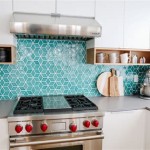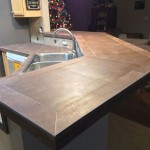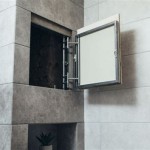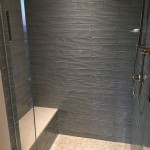The Right Edge To Finish Your Tile Countertops
The installation of tile countertops is a multifaceted project encompassing more than simply adhering tiles to a prepared surface. A critical, often overlooked, element in this process is the selection and application of the appropriate edge treatment. The edge of a tile countertop serves not only as a visual finishing touch but also plays a vital role in protecting the underlying substrate, preventing chipping of the tile, and ensuring user safety. Selecting the right edge treatment requires careful consideration of aesthetics, functionality, budget, and the overall design scheme of the kitchen or bathroom.
The edges of tile countertops are inherently vulnerable. Without proper protection, they are susceptible to damage from impacts, moisture penetration, and general wear and tear. A well-chosen and skillfully applied edge treatment provides a durable barrier against these elements, extending the lifespan and maintaining the aesthetic appeal of the countertop. Furthermore, a properly finished edge can significantly enhance the safety of the countertop by eliminating sharp or uneven surfaces that could potentially cause injury.
This article will delve into the various options available for finishing the edges of tile countertops, exploring their respective advantages, disadvantages, and typical applications. Consideration will be given to the materials used, the installation techniques employed, and the factors that influence the selection of the most suitable edge treatment for a given project. Understanding these aspects is crucial for achieving a professional, durable, and visually appealing tile countertop installation.
Understanding the Importance of Edge Treatment
The importance of selecting and implementing the correct edge treatment for tile countertops cannot be overstated. A poorly executed edge can detract from the overall aesthetic of the space, compromise the structural integrity of the countertop, and even pose safety hazards. Therefore, a thorough understanding of the functions and considerations involved is essential.
One primary function of the edge treatment is protection. Raw tile edges are porous and prone to chipping and cracking, especially when subjected to daily use and potential impacts. An edge treatment provides a protective layer that absorbs these impacts, preventing damage to the tile and extending the life of the countertop. This is particularly important in high-traffic areas or kitchens where the countertop is frequently used for food preparation.
Another key function is moisture resistance. The grout lines between tiles, and the raw edges of the tiles themselves, are potential entry points for water and other liquids. If moisture penetrates the underlying substrate, it can lead to mold growth, structural weakening, and costly repairs. A well-sealed edge treatment effectively prevents moisture penetration, ensuring the long-term durability and hygiene of the countertop.
Furthermore, the edge treatment significantly impacts the overall aesthetic of the countertop. It provides a visual transition between the tile surface and the surrounding environment, creating a finished and polished look. The choice of edge treatment can complement the style of the tile, the hardware, and the overall design of the room. Options range from simple and utilitarian to decorative and elaborate, allowing for customization to suit individual preferences.
Finally, safety is a crucial consideration. Raw tile edges can be sharp and uneven, posing a risk of cuts and scrapes. A properly finished edge eliminates these sharp edges, creating a smooth and safe surface. This is especially important in homes with children or elderly individuals, where the risk of injury is higher.
Exploring Different Edge Treatment Options
Numerous options exist for finishing the edges of tile countertops, each with its unique characteristics, advantages, and disadvantages. The selection of the appropriate edge treatment will depend on factors such as the type of tile used, the desired aesthetic, the budget, and the skill level of the installer. Some of the most common options include bullnose tiles, quarter-round tiles, metal edging, solid surface edging, and epoxy grout.
Bullnose Tiles: Bullnose tiles feature a rounded or curved edge, specifically designed to provide a smooth and finished look to the edge of the countertop. These tiles are typically manufactured with a glazed finish that matches the rest of the tile, creating a seamless transition. Bullnose tiles are a popular choice because they are relatively easy to install and offer a clean and classic aesthetic. However, they can be more expensive than standard tiles and may not be available in all colors and styles.
Quarter-Round Tiles: Similar to bullnose tiles, quarter-round tiles also feature a curved edge, but with a smaller radius. They are often used to create a more subtle and less pronounced edge. Quarter-round tiles are a good option for those who prefer a softer look or for countertops with limited overhang. Like bullnose tiles, they are relatively easy to install and provide a durable and water-resistant edge. However, selection of color and style may also be limited.
Metal Edging: Metal edging, often made of aluminum, stainless steel, or brass, provides a durable and modern-looking edge for tile countertops. Metal edging is available in a variety of profiles, including L-shaped, U-shaped, and T-shaped, allowing for different design options. Metal edging is particularly well-suited for contemporary kitchens and bathrooms, and it offers excellent protection against chipping and moisture penetration. However, it can be more challenging to install than bullnose or quarter-round tiles, requiring precise cutting and fitting. The cost of metal edging can also vary depending on the material and profile chosen.
Solid Surface Edging: Solid surface materials, such as Corian or similar acrylic-based products, can be used to create custom edge profiles for tile countertops. Solid surface edging offers a seamless and elegant look, and it can be fabricated to match the color and texture of the tile. Solid surface edging is highly durable and resistant to moisture, making it an excellent choice for high-use areas. However, it is typically more expensive than other edge treatment options, and it requires specialized tools and skills for installation. The process typically involves bonding the solid surface material to the edge and then sanding and polishing it to create a smooth and seamless transition.
Epoxy Grout: While typically used to fill the gaps between tiles, epoxy grout can also be used to create a rounded edge for tile countertops. This method involves carefully applying epoxy grout along the edge of the countertop and then shaping it to create a smooth, rounded profile. Epoxy grout is highly durable and water-resistant, making it a good option for protecting the edge of the countertop. However, it requires a high level of skill and precision to achieve a consistent and professional-looking result. The color selection may also be limited to standard grout colors.
Factors Influencing Edge Treatment Selection
The process of selecting the most appropriate edge treatment for a tile countertop involves careful consideration of several factors, including the type of tile used, the desired aesthetic, the budget, and the skill level of the installer. Ignoring these factors can lead to an unsatisfactory outcome, compromising the durability, appearance, and safety of the countertop.
Tile Type: The type of tile used for the countertop will significantly influence the choice of edge treatment. For example, ceramic or porcelain tiles are often paired with bullnose or quarter-round tiles, as these options provide a seamless and visually appealing transition. Natural stone tiles, such as granite or marble, may be better suited for solid surface edging or metal edging, as these options can complement the natural beauty of the stone. The thickness of the tile is also a factor, as the edge treatment must be compatible with the tile's thickness to create a flush and even surface.
Aesthetic Considerations: The desired aesthetic of the countertop and the overall design scheme of the kitchen or bathroom are crucial factors in edge treatment selection. A modern and minimalist design may call for metal edging or a simple epoxy grout edge, while a more traditional or rustic design may be better suited for bullnose or solid surface edging with a decorative profile. The color and texture of the edge treatment should also complement the tile and the surrounding elements, creating a cohesive and harmonious look. The goal is to achieve a visually appealing and balanced design that enhances the overall ambiance of the space.
Budget Constraints: The budget allocated for the countertop project will also play a significant role in the selection of the edge treatment. Bullnose and quarter-round tiles are generally the most cost-effective options, while solid surface edging is typically the most expensive. Metal edging falls somewhere in between, depending on the material and profile chosen. When considering the cost, it is important to factor in not only the price of the materials but also the labor costs associated with installation. Some edge treatments require specialized tools and skills, which can increase the overall cost of the project.
Installation Skill Level: The skill level of the installer is another important consideration. Some edge treatments, such as bullnose and quarter-round tiles, are relatively easy to install and can be tackled by experienced DIYers. Other edge treatments, such as metal edging and solid surface edging, require more specialized tools and skills, and are best left to professional installers. Attempting to install an edge treatment beyond one's skill level can lead to a subpar result, compromising the durability and appearance of the countertop. It is always advisable to seek professional assistance if unsure about the proper installation techniques.
In addition to these primary factors, other considerations may include the level of maintenance required for the edge treatment, the availability of matching or complementary materials, and the potential for future repairs or replacements. A thorough assessment of all these factors will help ensure that the selected edge treatment is not only aesthetically pleasing but also durable, functional, and cost-effective.

How To Choose The Right Countertop Edge

Installing Tile Countertops Ceramic Kitchen Diy

Installing Tile Countertops Ceramic Kitchen Diy

All You Need To Know About Tile Countertops Bob Vila

Tile Countertop Installation Disaster Elisa S Ramblings

How To Install A Kitchen Backsplash The Best And Easiest Tutorial

4 Easy Ways To Finish Tile Edges Msi Surfaces

How To Choose Tile Trim And Edging Like A Pro

How To Repair And Refinish Laminate Countertops

Concrete Countertop Diy A Beautiful Mess
Related Posts








